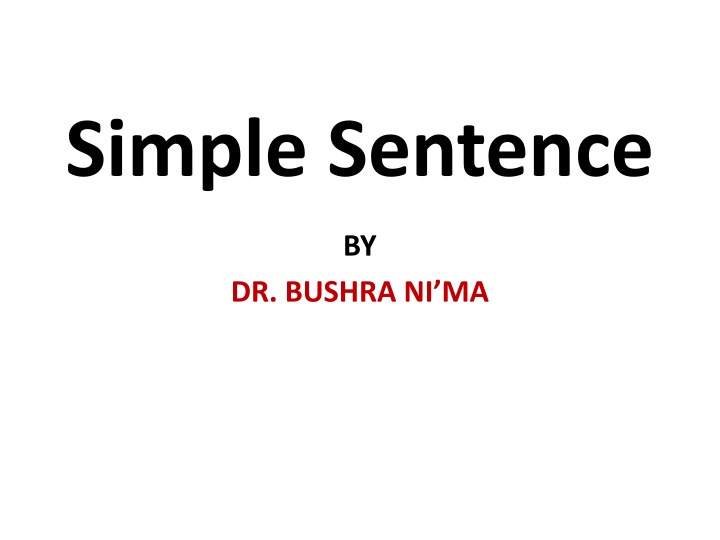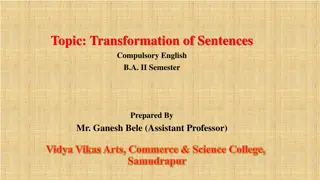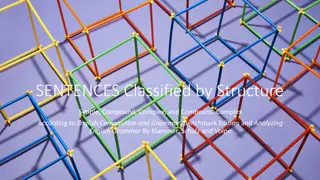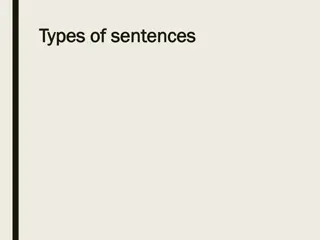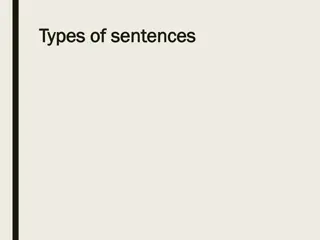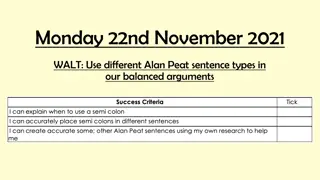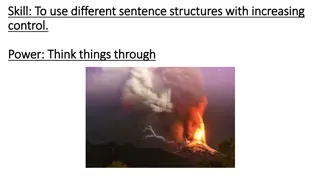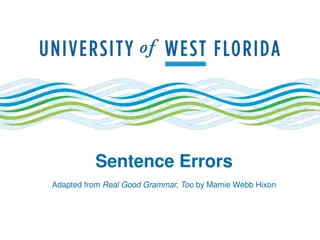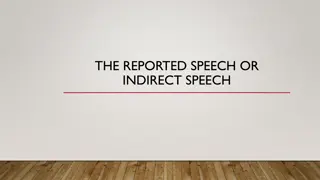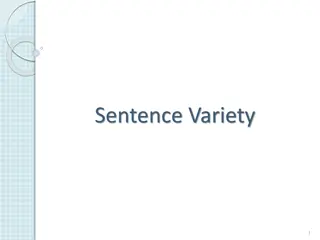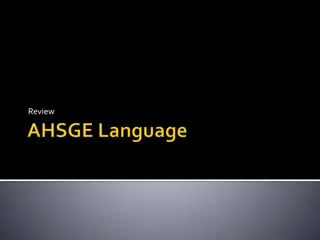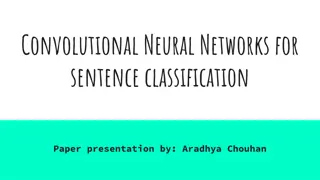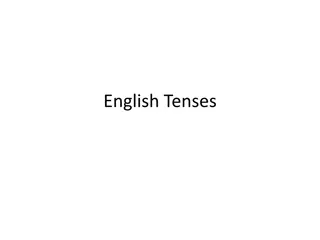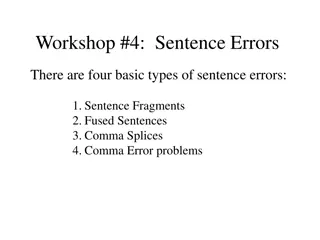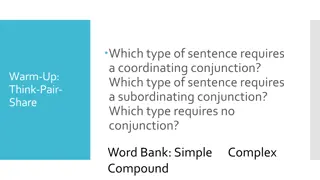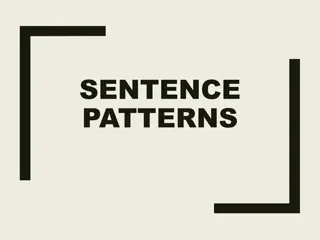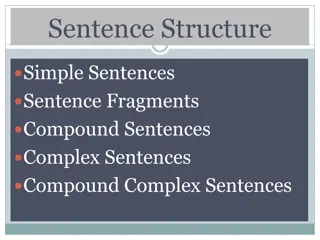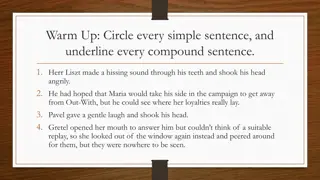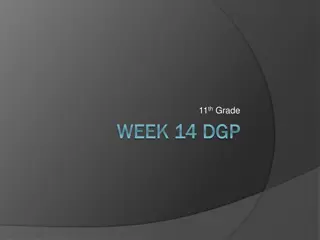Simple Sentence
The various types of negation in language, including clause negation, local negation, and predication negation. Learn how negation is realized through the use of negative items and how the scope of negation can influence the meaning of a sentence. Examples and exercises provided for better understanding.
Uploaded on Feb 24, 2025 | 1 Views
Download Presentation

Please find below an Image/Link to download the presentation.
The content on the website is provided AS IS for your information and personal use only. It may not be sold, licensed, or shared on other websites without obtaining consent from the author.If you encounter any issues during the download, it is possible that the publisher has removed the file from their server.
You are allowed to download the files provided on this website for personal or commercial use, subject to the condition that they are used lawfully. All files are the property of their respective owners.
The content on the website is provided AS IS for your information and personal use only. It may not be sold, licensed, or shared on other websites without obtaining consent from the author.
E N D
Presentation Transcript
Simple Sentence BY DR. BUSHRA NI MA
BASIC INFORMATION NEGATION
GENERAL TYPES OF NEGATION CLAUSE NEGATION the whole clause is syntactically treated as negative: She s not an attractive woman in any respect(, is she?) LOCAL NEGATION one constituent (but not necessarily a clause element) is negated: She s a not unattractive woman in some ways. (NOT: in any respect) PREDICATION NEGATION very rare, applies only after certain auxiliaries (often depends on pronunciation): They may not go swimming. [=They are allowed not to go swimming] NEGATION IS REALIZED THROUGH USE OF NEGATIVE ITEMS.
NEGATION via NEGATIVE ITEMS The clause can be negated: EITHER BY NEGATING THE VERB, OR BY NEGATING OTHER SENTENCE ELEMENTS. Depending on what sentence element is being negated, it is necessary to use different negative items: VERB NEGATION: the negative particle NOT is always used: He does not diging. She is not a model wife. NEGATION OF OTHER SENTENCE ELEMENTS can be achieved using DIFFERENT NEGATIVE ITEMS: Words negative in form and meaning: no, none, never, not Word negative in meaning only (not negative in form): rarely, seldom, scarcely, barely, little, few VERBS, ADJECTIVE, PREPOSTIONS with IMPLIED NEGATIVE MEANING: refuse, deny, fail; reluctant, unaware; without, against; unless
NEGATION: SCOPE OF NEGATION The SCOPE OF NEGATION is the stretch of language OVER WHICH THE NEGATIVE MEANING OPERATES AND WHERE NON-ASSERTIVE ITEMS MUST BE USED. The SCOPE OF NEGATION EXTENDS FROM THE NEGATIVE ITEM TO: THE END OF THE CLAUSE (NOT NECESSARILY THE END OF THE SENTENCE), THE END OF THE NEGATED PHRASE (IF ONLY A SINGLE PHRASE IS NEGATED), OR THE BEGINNING OF THE FINAL ADJUNCT. WHY IS THIS SUCH A BIG DEAL? The POSITION OF THE NEGATIVE ITEM may drastically INFLUENCE THE MEANING OF THE WHOLE SENTENCE:
SCOPE OF NEGATION She definitely didn t speak to him. = It is definite that she didn t speak to him. She didn t definitely speak to him. = It is not definite that she spoke to him.
PAGE 145 exercise 9 (a-d) THERE AREN T ANY STUDENTS IN THE CLASSROOM YET. I WOULDN T LIKE TO GO ANYWHERE FAR AWAY. WE CANNOT BE FRIENDS ANY MORE/ANY LONGER. HE HAS NEVER/RARELY GIVEN ME ANY USEFUL ADVICE.
PAGE 145 exercise 9 (e-h) YOU CAN T PARK EITHER ON THE LEFT OF RIGHT HERE. THE WEATHER DOESN T SEEM ANY BETTER. SUSAN WILL NEVER MANAGE TO DO ANYTHING USEFUL. THERE WAS NO CHANCE ANYBODY WOULD COME.
PAGE 145 exercise 9 (i-l) BILL WAS UNENTHUSIASTIC TO READ ANY OF THE BOOKS. NO PROBLEM CAN BE SOLVED LIKE THAT. LITTLE OF THE FOOD WAS BAD. THEY WON T GO SHOPPING.
PAGE 146 exercise 10 (REALLY,) I (REALLY) DON T (REALLY) UNDERSTAND. THAT (SIMPLY) IS (SIMPLY) NOT ACCEPTABLE. I (DEFINITELY) DON T (DEFINITELY) KNOW (DEFINITELY) WHAT . (EVEN) HE (EVEN) DOESN T (EVEN) TRY (EVEN).
BASIC INFORMATION SENTENCE TYPES AND DISCOURSE FUNCTION
Sentence types and discourse functions
PAGE 146 exercise 11 (a-d) WHAT IS HER NAME? WHERE DOES SHE COME FROM? DID SOMEONE CALL HER LAST NIGHT? CAN T YOU GIVE US ANY HELP?
PAGE 146 exercise 11 (e-h) YOU VE GOT YOUR CAMERA WITH YOU? SHALL WE TRAVEL BY BUS OR TRAIN? HASN T SHE GROWN! IS THAT A REASON FOR DESPAIR?
Thank you for your time! THE END
